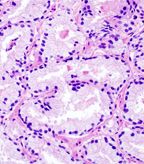Potential Target for Castration-Resistant Prostate Cancer Discovered
Researchers have identified a mechanism by which prostate cancer resists hormonal therapy to develop into castration-resistant prostate cancer (CRPC). The protein SIAH2 keeps a fraction of androgen receptors constitutively active in prostate cancer cells.
Researchers have identified a mechanism by which prostate cancer resists hormonal therapy to develop into castration-resistant prostate cancer (CRPC). Ze'ev Ronai, PhD, associate director of Sanford-Burnham’s National Cancer Institute-designated Cancer Center in La Jolla, California, and colleagues from the Vancouver Prostate Centre at the University of British Columbia discovered the protein SIAH2, which keeps a fraction of androgen receptors constitutively active in prostate cancer cells.

Acinar adenocarcinoma obtained by core needle prostate biopsy; source: KGH, Wikimedia Commons
The authors of the study, published in Cancer Cell, see SIAH2 as an attractive biomarker and a potential therapeutic target. Inhibiting the interaction of SIAH2 with the androgen receptor may be a way to overcome resistance of castration-resistant prostate tumors to current hormonal therapies.
Prostate cancer is treated with androgen deprivation therapy (ADT), reducing the level of androgens that prostate cancer cells use to drive tumor growth. Hormone therapies include luteinizing hormone-releasing hormone analogs, which lower androgen production by the testes and luteinizing hormone-releasing hormone antagonists, such as degarelix, which are used to treat advanced prostate cancer. Other therapies include oral anti-androgens, such as flutamide, bicalutamide, and nilutamide.
Newer forms of hormone therapy have recently been developed and approved, which more effectively block the activity of androgens produced by the testes and other cells in the body, including in the adrenal glands. Abiraterone (Zytiga) blocks the enzyme CYP17, which functions to make the precursor for testosterone. The oral therapy is used to treat men with advanced castration-resistant prostate cancer (CRPC) that continues to grow despite treatment with hormonal therapy. Another drug recently approved for treatment of CRPC is enzalutamide (Xtandi), an anti-androgen therapy that blocks the binding of testosterone to androgen receptors.
Despite these new developments, resistance to these new therapies still remains an issue. One way prostate tumors become CRPC is through the constitutive activity of androgen receptors, but the mechanisms of how this happens is complex since alterations in the androgen receptors have only been found in a portion of CRPC tumors. Identifying the mechanisms of CRPC is a way to identify new ways to prevent resistance for longer-term treatment and tumor growth inhibition.
The newly identified protein, SIAH2, is a ubiquitin ligase that is required for prostate cancer cell growth under androgen-inhibiting conditions, both in vivo and in vitro. Based on several mouse models, as well as tissue culture experiments, the authors demonstrate that inhibiting SIAH2 promotes regression of prostate cancer after castration. The study also showed that human CRPC tumors have elevated expression of SIAH2.
Overall, SIAH2 was found to regulate the transcriptional activity of androgen receptors important for CRPC development-essentially, SIAH2 removes the break of androgen receptor activity.
Navigating Treatment Intensification in Metastatic Hormone-Sensitive Prostate Cancer
A patient case of a 50-year-old man with hormone-sensitive prostate cancer sparked a debate among oncologists regarding the best course of action.